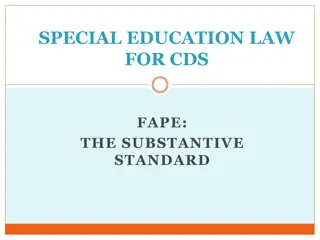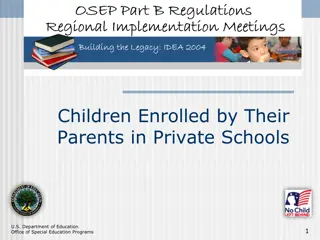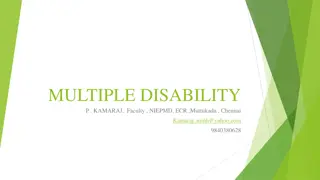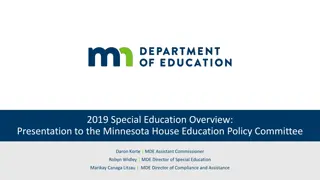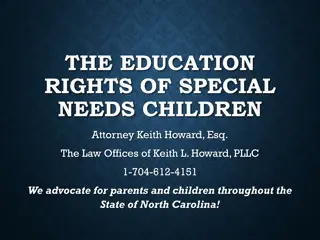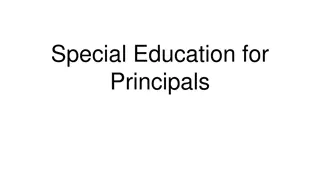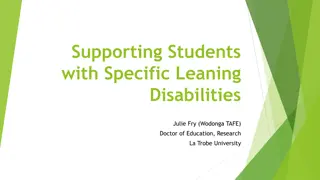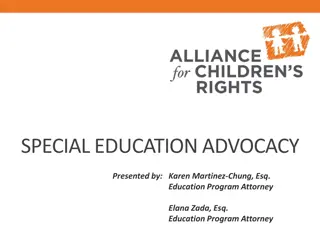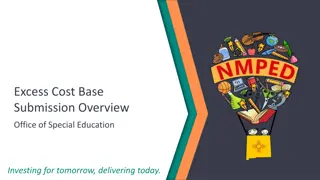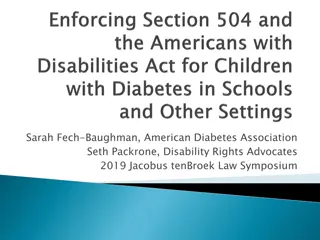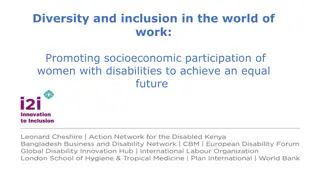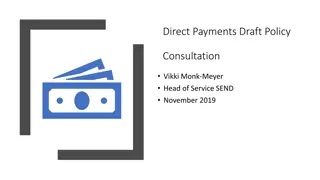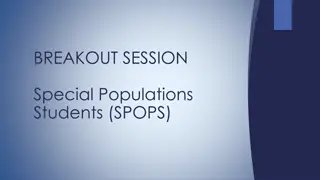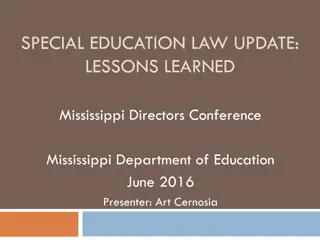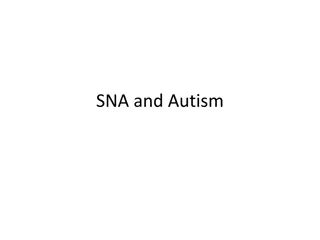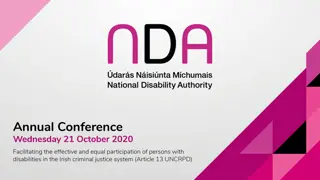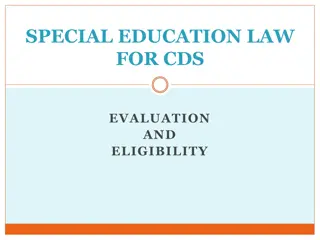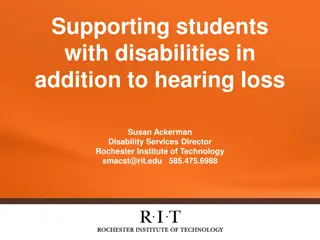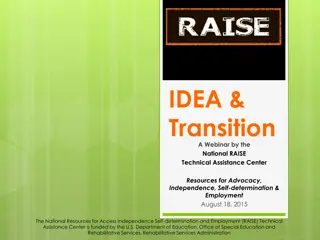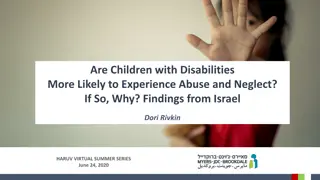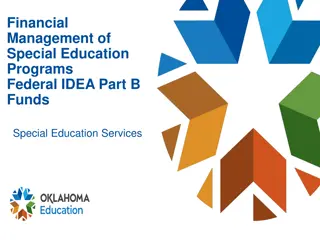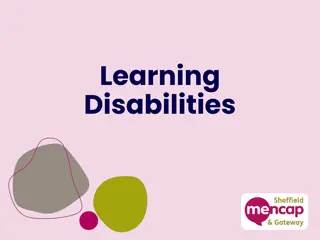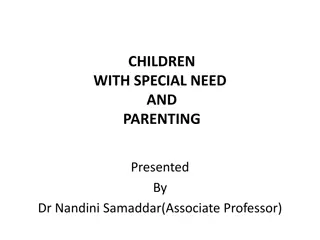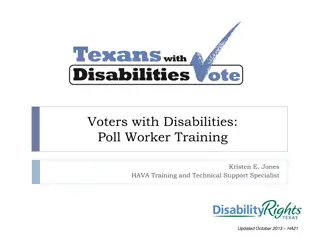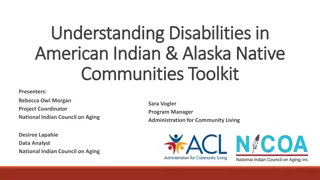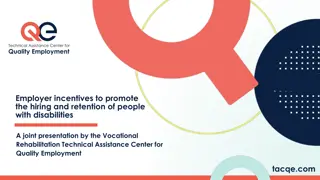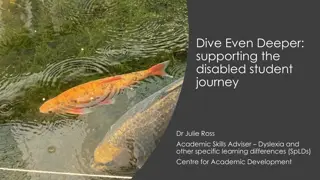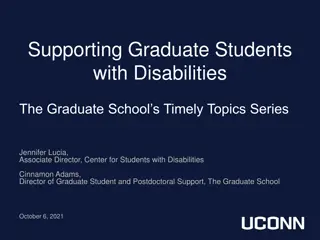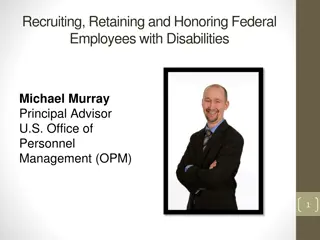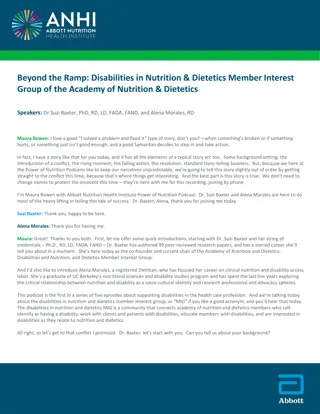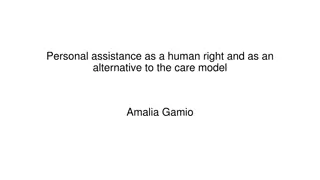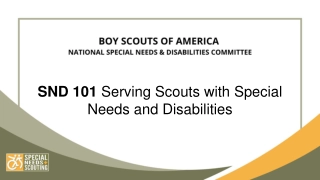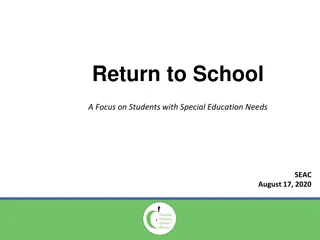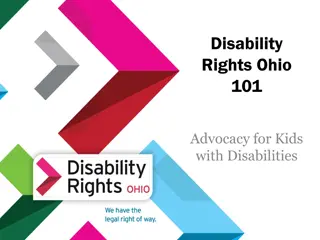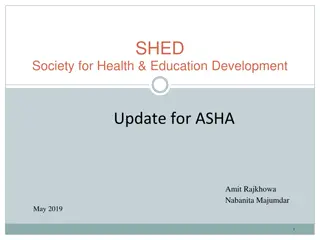Understanding Special Education Law for Children with Disabilities
This course provides an in-depth exploration of the legal framework surrounding special education for children with disabilities, focusing on key terms and concepts. It covers laws such as IDEA Part B, Section 619, and MUSER applicable to students aged 3 to school-age 5. Participants will engage in discussions with special educators/administrators to enhance their understanding and application of the law.
Download Presentation

Please find below an Image/Link to download the presentation.
The content on the website is provided AS IS for your information and personal use only. It may not be sold, licensed, or shared on other websites without obtaining consent from the author. Download presentation by click this link. If you encounter any issues during the download, it is possible that the publisher has removed the file from their server.
E N D
Presentation Transcript
SPECIAL EDUCATION LAW FOR CDS INTRODUCTION LEGAL FRAMEWORK KEY TERMS AND CONCEPTS
This course will: Provide an overview of the laws and regulations mostly IDEA Part B, Section 619 and MUSER applicable to students with disabilities from age 3 to school-age 5 Give you the opportunity to discuss application of the law with special educators/administrators
Outline Week 1: Introduction, Legal Framework, Key Terms and Concepts Week 2: Child find, Referrals, Records, and the Role of the IEP Team Week 3: Evaluations and Eligibility Week 4: FAPE The Procedural Requirements
Outline Week 5: FAPE The Substantive Standard Week 6: LRE, Placement, and Change of Placement Week 7: The Procedural Safeguards, including Dispute Resolution
What is the law? Constitution The source of all law No mention of education in US Constitution Education specifically mentioned in Maine Constitution Spending Clause/General Welfare Clause Fourteenth Amendment equal protection, due process Statute A law passed by a legislative body Broad statements of policy IDEA, Title 20-A, Chapters 301 & 303
the law Regulation/Rule Promulgated by executive agencies Major substantive rules legislative approval Implements, interprets or makes specific the law administered by the agency Part 300, MUSER Guidance/everything else NOT THE LAW Dear Colleague letters FAQs/Q&As
Legal History 1954 Brown v. Board of Education 1971-72 PARC and Mills 1973 Section 504 of the Rehabilitation Act 1975 Education for All Handicapped Children Act Individuals With Disabilities Education Act (IDEA)
Public Education A birthright State, not federal, constitutions Boys of means . . . boys and girls . . . all boys and girls regardless of race . . . Compulsory education laws All children within a certain age range Sanctions for non-compliant parents Right to choose private/alternative education (Pierce) Interpretation of compulsory education laws to exclude students deemed uneducable Actual language excluding the uneducable
Brown vs. Bd. of Education (1954) In these days, it is doubtful that any child may reasonably be expected to succeed in life if he is denied the opportunity of an education. Such an opportunity, where the state has undertaken to provide it, is a right that must be made available to all on equal terms.
Equal Protection of the Law Brown: classes of individuals entitled to equal protection Black students had the same right to attend public schools as white students, so . . . Students with disabilities had the same right to attend public schools as non-disabled students?
PARC and Mills (1971-72) Two cases challenging state statutes and policies that excluded students with disabilities from public education Both cases were class actions; PARC resolved by consent agreement Language from PARC and Mills appears in the IDEA to this day
PARC In 1972, the PARC Court found that retarded children in Pennsylvania were entitled to placement in a free, public program of education and training appropriate to the child s capacity, within the context of a presumption that . . . placement in a regular public school class is preferable to placement in a special public school class and placement in a special public school class is preferable to placement in any other type of program of education and training . . .
Mills In 1972, the Mills case examined the rights of all children with disabilities The Mills Court found that the failure to provide a public education cannot be excused by the claim that there are insufficient funds The Mills Court adopted a comprehensive plan that included: 1. A free appropriate education 2. An individualized educational plan 3. Due process procedures
Section 504 of the Rehab. Act (1973) No otherwise qualified handicapped individual in the United States . . . shall, solely by reason of his handicap, be excluded from the participation in, be denied the benefits of, or be subjected to discrimination under any program or activity receiving Federal financial assistance.
Section 504 Applies to any agency receiving federal funds No dedicated funds to pay for compliance Huge impact on public schools Need for financial assistance identified
Education for All Handicapped Children Act (EAHCA) (1975) A free appropriate public education 1. 2. An individualized education program 3. Special education services 4. Related services 5. Least restrictive environment 6. Due process procedures
EAHCA IDEA 1986 Children aged 3-5 included in Part B Section 619 1986 Part H (now Part C) added to serve infants and toddlers with disabilities aged B-2 1990 Name changed to IDEA 1997 Part H renamed Part C; Recognition that LRE applies to 3-5 year olds 2004 Current reauthorization
IDEA 2004 Alignment of IDEA with NCLB Defined highly qualified special education teachers Changed the rules for LD identification Addressed IEP Team participation Removed short term objectives from most IEPs Allowed amendments of IEPs without a Team meeting Changed the discipline rules (again) Clarified dispute resolution processes
IDEA Today Key terms/concepts derive nearly verbatim from PARC and Mills cases Statute has never been organized substantively; 2007 regulations are grouped substantively for the first time Each statutory principle has been informed over the years by case law
Key Components of IDEA Zero reject principle Protection in evaluation Free, appropriate public education (FAPE) The least restrictive environment (LRE) Parental participation in decision making Procedural Safeguards
Zero Reject Each SEA and LEA responsible for identifying, and serving all children with disabilities aged 3-21 (3-5 if accept Section 619 funds) Timothy W. v. Rochester, NH, School District, 875 F.2d 954 (1stCir. 1989) All children with disabilities without exception (regardless of severity of disability) No requirement that child be able to benefit
Zero Reject Child is eligible for services under Part B of the IDEA if: The child has a disability that is covered under the IDEA, or developmental delay if the State has chosen to allow it for children aged 3-9 (or a subset thereof); and By reason thereof, the child needs special education and related services. Regulations add: Adversely effect educational performance
Protection in Evaluations Evaluations must be completed in a timely manner at no cost Evaluation materials Non-discriminatory Native language Technically sound instruments Administered by qualified personnel Determine what students can do, not just what they cannot
Protection in Evaluations Assess in all areas of suspected disability Use a variety of assessment tools and strategies to collect information Documentation Eligibility decisions made by a Team including the parent
Free, Appropriate Public Education Special education and related services Provided at public expense and under public supervision Meet the standards of the state education agency Include an appropriate preschool, elementary or secondary education In accordance with the child s IEP
Rowley (1982) Has the state [LEA] complied with the procedures in the Act? and Is the IEP reasonably calculated to enable the child to receive educational benefit? We hold that the state [LEA] satisfies the FAPE requirement by providing personalized instruction with sufficient support services to permit the child to benefit educationally from that instruction.
Endrew F. (2017) A student s IEP must be appropriately ambitious in light of his circumstances, just as advancement from grade to grade is appropriately ambitious for most children in the regular classroom. The goals may differ, but every child should have the chance to meet challenging objectives.
Least Restrictive Environment To the maximum extent appropriate, children with disabilities are to be educated with children who are not disabled Removal may occur only when education in regular classes with the use of supplementary aids and services cannot be achieved satisfactorily
Least Restrictive Environment In the school the child otherwise would attend Continuum of placements must be available Regular education classes Reverse mainstream /weighted classes Special classes Special schools Hospitals, institutions, home
Parental Participation Notice of IEP Team meetings Opportunity to participate in IEP Team meetings Consent Initial evaluations Initial provision of services Reevaluations Withdrawal of consent Prior Written Notice What school proposes or refuses to do Why? Based on what? What was considered/rejected?
Procedural Safeguards Written document Right to participate in decisions about education of the child/have appropriate individuals present Right to determine whether child will receive special education and related services - consent
Procedural Safeguards Right to examine child s education records and protect confidentiality of information about child (and family) Right to engage in dispute resolution Mediation State complaint investigation Due process hearing


